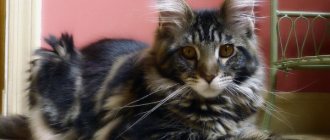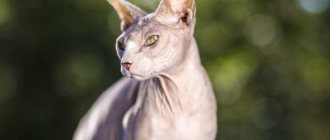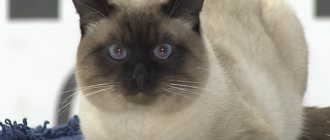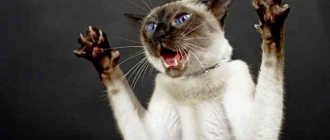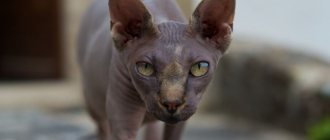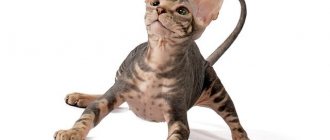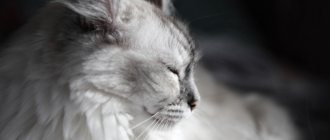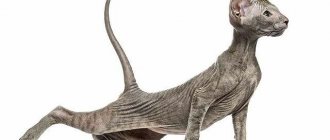Historical information
The Canadian and Don sphinxes appeared in the second half of the 20th century.
- The Canadian Sphynx comes from the province of Ontario. In 1966, the cat family acquired an unusual offspring: a bald baby. The breeders decided to consolidate this feature. American breeders got involved in the process, and as a result of closely related breeds, they were lucky to achieve the desired result. The standard of the Canadian Sphynx cat was recognized by the International Felinological Organization, and the Canadian breed was allowed for breeding and participation in national and international exhibitions.
- The Don Sphynx is a species bred in Russia. The work began in 1986 in Rostov-on-Don. The cat of breeder E. Konovalova, named Varvara, began to lose hair on her back and head. The treatment did not produce any results. The owner of one of Varvara’s kittens, Irina Nemykina, began experiments with matings and achieved amazing results. The daughter of a cat from Rostov consistently gave birth to hairless kittens. In 1996, the Don Sphynx breed was officially registered.
The history of the origin of “bald” breeds
The official history of the Sphynx is very short, but hairless cats, as a result of a genetic mutation, have appeared next to humans since ancient times. Attitudes towards this miracle of nature could be very different: in ancient times they were attributed healing and almost magical qualities, in the Middle Ages they were burned for.
Hairless cat - a genetic error or a miracle of nature?
There is information about an ancient breed of hairless Mexican cats, which, unfortunately, completely disappeared at the beginning of the last century. But these legendary hairless cats and modern hairless cats have a common origin, based on a spontaneous genetic mutation, fixed and passed on to offspring.
This is what hairless Mexican cats looked like
There are several known hairless cat breeds, both generally recognized and experimental. Some of them were obtained by fixing a spontaneous mutation, and the rest were the result of interbreeding.
Photo gallery: modern hairless cats
The Canadian Sphynx as a breed has a history of half a century ago.
The Don Sphynx is a young, but very popular and promising breed of hairless cats.
Petersburg Sphynx, or Peterbald - to create the breed, the blood of oriental cats was infused into the Don Sphynxes. Ukrainian Levkoy - a derivative of the Don Chak and Scottish Fold
Elf is a product of crossing Canadian Sphynxes with American Curls
Bambino is a miniature cat obtained from the union of Canadians and munchkins.
Dwelf is the fruit of a triple selection of Curls, Munchkins and Canadians
The Cohona, or Hawaiian Hairless, is the result of a mutation, a breed so rare that its very existence is in question.
Don Sphynx
The Don Sphynx is a young breed of Russian selection. It is generally accepted that all Don Chaks descend from the cat Varvara, a blue-cream “tortoise” who was found by a kind woman in Rostov-on-Don in February 1986 as a very small kitten. Having picked up the unfortunate baby just on the street, Elena Kovaleva fed her and treated her, but the cat’s fur did not grow back. The cat's body was velor, and its tail, paws and frill remained fluffy.
Moreover, when the matured Varvara became a mother, a hairless kitten was found in the litter, also a girl, named Chita. It is from this moment—since 1990—that the official history of the Don Sphinxes begins. Elena’s friend, Irina Nemykina, although she was not a felinologist at that time, was the first to recognize the signs of sphinxes in the amazing cats. Having received baby Chita as a gift, she actively began self-education and selection of a new breed.
Irina Nemykina and her cat Chita “invented” a new breed of Sphynx
The first breeding nursery of the Don Sphynx was called “Myth”; the famous cat Hannibal, who is in the pedigree of every Donchak, was obtained here. Close crossing of Hannibal with his mother Chita made it possible to obtain completely hairless kittens and fix the genotype of the new breed. Strange cats - Sphynx cats of Russian breeding - were shown at exhibitions of aboriginal breeds, and they very quickly gained popularity.
In 1992, the number and quality of the livestock made it possible to create the first, experimental standard of the domestic breed, and in 1998, the Don Sphynxes finally received international recognition at the conference of the World Cat Federation (WCF), and at the same time the final name of their breed, which until then was called differently:
- Don balder;
- Russian hairless;
- Russian naked.
Irina Nemykina with her modern pet
However, the name does not change the essence of the fact that the young breed of Sphynx of Russian selection quickly became famous, popular and in demand throughout the world. Today there are four breed standards:
- ICEF;
- WFF;
- MALK RUI;
- WCF.
An adult Donchak looks unusual and solid
Such well-known felinological organizations as FIFE and TICA are also considering the issue of recognizing the Don sphinxes.
Video: all about the Don sphinxes
Canadian Sphynx
The first attempt to create a breed of Canadian Sphynx was, alas, unsuccessful. It dates back to 1966, when a hairless kitten, Prune, appeared in a litter of ordinary domestic cats from the province of Ontario, which immediately attracted the interest of local felinologists. Despite their efforts, it was not possible to create a new breed based on this random mutation.
“Lysik” Prun was actively mated with his mother, sisters, daughters and just cats of different breeds, but the hairless offspring that resulted were small in number, weak, and unstable in phenotype. In addition, the breeders did not have a common strategy and a unified vision for the new breed, which, by the way, immediately received the name “Canadian Sphynx” and experimental status from the CFA. This felinological organization was forced in 1971 to revoke the status it had issued.
Sphynx cats are sometimes called "moon cats"
A second chance appeared only nine years later, with the birth of a naked baby to another parent couple. A kitten named Epidermis eventually became the ancestor of the Canadian Sphynx. Around the same time, three more “balds” were found just on the streets, two of whom took a direct part in the formation of the breed.
At the first stages of selection, Devon Rex blood was actively infused into the small Canadians to expand their gene pool and create the desired type, features of which to this day are sometimes visible in purebred Canadian Sphynxes. Experienced American and European felinologists carried out breeding work in the breed. All authoritative felinological organizations in the world today have already recognized the Canadian sphinxes.
Video: everything about the Canadian sphinxes
Different breed genetics
Canadian Sphynx cats are not allowed to be mated with other breeds. The hairless mutation in the offspring of these cats is guaranteed by the recessive HR gene. The original breeding involved Devon Rex, and HR continues to provide information about the differences in the genome of their offspring.
The appearance of the Don Sphinx is a pure coincidence. Domestic breeders were inspired to develop a new breed by the existence of their Canadian counterpart. But the true cause of the baldness of the ancestor of the breed has not yet been determined. Most likely, hair loss is caused by the presence of a dominant HBL allele, a gene responsible for the development of certain traits.
Important! Genetic difference between the Canadian and Don Sphynxes in the cause of hair loss. In the domestic species, the anomaly is caused by a dominant gene. For a Canadian, it is repressed (recessive).
How to distinguish a Don Sphynx from a Canadian one by appearance The difference between the two hairless breeds is obvious when carefully studying individual parts of their portrait:
| Comparison options | Canadian Sphynx | Don Sphynx |
| Body | Elegant, fine-boned. | Dense, with a well-developed chest. |
| Paws | Long, elastic. The front legs are longer than the hind legs and crooked. | Middle length. |
| Tail | Tapered at the end, with a tassel that gives it a lion-like appearance. | Straight, flexible and resilient. |
| Leather | It has many folds on the neck and armpits, and is covered with barely noticeable, short fluff. | Smooth, without hairs. In some species, kittens have fur at birth, which subsequently falls out. |
| Head | Rounded, with pronounced cheekbones and an indistinct transition from forehead to nose. | Wedge-shaped, sloping forehead, clearly prominent cheekbones. |
| Eyes | Large, round shape, various shades. | Medium size, almond-shaped, slanting, often amber in color. |
| Neck | Medium length, muscular, slightly arched. | Graceful and strong at the same time. |
| Ears | Large, wide at the base, with a slight edge on the outside. | Set high, slightly leaning forward, with rounded tips. |
Description of the breed
Without a certain competence in the field of knowledge about it, it is difficult to distinguish between being a Donchak or a Canadian . In fact, both varieties have their own characteristics that are unique to them. Each type has its own set of characteristics.
Don sphinxes
They have Russian roots. The breed was developed through a natural process of mutation. Its representatives cannot have lint. Its absence can be complete or partially manifested. Depending on this, three subgroups are distinguished:
- rubber - they immediately lack a fur coat,
- velor – velvety to the touch,
- Brush - owners of short fur, which disappears at 1.5-2 years.
The muzzle has the outline of a wedge, the cheekbones and eyebrows protrude sharply. The body is muscular, wide croup. The chest is large in volume. The paws are well developed, with long and tenacious fingers on their rounded pads, similar to a human hand. There are short whiskers that help to navigate in space.
Canadian
They cannot be completely hairless - there is a thick layer of hair on the limbs, groin and tail. No mustache at all. The head is small, wide cheekbones. The transition to the nose is clearly defined. The distance between the straight ears is large.
The eyes are round and lemon-like. The gap between them is equal to the size of one of them. The color matches the main color.
The parameters are average. The muscles are normally developed, but the animal looks graceful. The skin feels like velor to the touch due to the short fuzz - up to 1-2 mm. It gathers into folds in the area of the ears, shoulders and muzzle.
Differences in Personality
When choosing a cat, you should first of all pay attention to its character and compatibility with family members. Fortunately, both Sphynx breeds are friendly and easy-going animals, but there are a few differences:
- Don Sphynxes are very kind and quickly find a common language with all family members. Kittens are constantly hovering underfoot, checking what the inhabitants of the house are doing, and are always ready to join in the game. Donchak people are not afraid of guests and welcome noisy companies.
- Canadians are more reserved and a little moody. From among the inhabitants of the house, they choose one whom they consider the owner and prefer to spend time only with him. They treat other animals calmly, but try to keep their distance. Some Canadians are characterized by aggressiveness when strangers try to establish close contact.
The character of animals is influenced by the atmosphere in which they live.
Characters of sphinxes
Even in terms of character, the Don and Canadian sphinxes have a number of differences. If we talk about Canadians, then these are rather reserved cats who are truly attached to only one family member, and perceive others only as a necessary appendage. In the absence of his “favorite,” a Canadian can easily hide somewhere, or settle separately from everyone else.
Be sure to read:
Hairless cats: popular breeds, characteristics, external features, how to care for and feed
How are the Don Sphynxes different? In this regard, they are the exact opposite. Their insatiable curiosity can even be dangerous for the cat. Although in other respects they are considered better balanced in character, and, at the same time, more affectionate. This is expressed in the fact that they are able to love more than just one person. For them, the concept of “family” is not an empty phrase.
Of course, there are exceptions to the rules, and a loving Canadian or a reserved Don Sphynx are not psychological anomalies at all, but simply character traits.
Caring for the Don and Canadian Sphynx
There are no differences in the content of the breeds:
- Skin care requires special attention. Sphynxes need to be bathed regularly, once every 15–30 days. The lack of fur requires animals to have an increased body temperature, so they sweat and quickly begin to emit an unpleasant odor.
- For bathing, use a special shampoo. Sphinxes may have an allergic reaction to other medications. Cats are bathed in water at a temperature of 37–39 degrees. Wash the Sphynx with a soft sponge, carefully treating all folds of the skin.
- Another important procedure for caring for animals is trimming their nails. Cut off only the very ends using sharp nippers or rounded nail scissors.
- An important nuance of proper maintenance of sphinxes is the organization of a balanced and nutritious diet. The optimal menu is a combination of special feed with natural products: lean meats, sea fish, vegetables, dairy products.
Character traits
Sphinxes, living in the vastness of Russia, are reminiscent of playful children in their disposition. These are perky creatures who are never characterized by aggression. They love human company very much. Sometimes this takes the form of obsession. Then the pebble appears everywhere your foot steps. He starts his song, rubbing himself against your hands or face.
The pronounced curiosity and desire to always be at the epicenter of events are striking. They treat strangers with interest, but do not always allow them to approach them once they reach puberty. They are sensitive with their family members and subtly sense people’s moods.
Their Canadian counterparts behave differently:
- choose their only owner,
- feel equal to a person, not allowing themselves to beg for food,
- sometimes show impulsiveness
- a little secretive, “on their own”
- restrained in their actions,
- Only a select few allow themselves to be caressed.
To read: Features of the West Highland White Terrier breed, the pros and cons of the dog
At the same time, they are all very peaceful. They are endlessly devoted to those who care about them.
Sphynx diseases
Most often, hairless cats suffer from skin diseases associated with violations of the rules of care. If the skin is not wiped daily, dirt and bacteria accumulate in the folds, which causes irritation and inflammation. Cats may experience the following problems:
- colds due to hypothermia;
- sunburn due to frequent walks without protective clothing;
- dermatitis or eczema - inflammatory processes due to allergies or vitamin deficiency in food;
- trichophytosis - a fungal skin disease when kept in unsanitary conditions;
- Dysbacteriosis - mainly affects animals kept on an unbalanced diet.
In addition to acquired ones, Canadian and Don Sphynxes may suffer from congenital genetic pathologies:
- Shortened lower jaw. If this abnormality is excessive, animals are excluded from breeding.
- Microphthalmos is underdevelopment of the eyeball. Associated pathologies are cataracts, keratitis, orbital cyst.
- Curvature of the caudal part of the spine. The disease is accompanied by underdevelopment of the lower intestines.
- Nipple hyperplasia is transmitted through the female line, sometimes accompanied by underdevelopment of internal organs.
- Entropion of the eyelid requires surgical intervention. If the operation is not performed, the animal will constantly suffer from inflammation of the cornea of the eye.
In general, sphinxes have good health and strong immunity. They get sick mainly in childhood and young adulthood. As you grow, your health becomes better. The average lifespan of cats is 12–15 years.
Features of the sphinxes
Despite its unusual appearance, the Sphynx cat is the friendliest creature in the world. There are interesting facts about sphinxes. These cats are believed to have the gift of healing. They lay precisely on the owner’s sore spot and take all the pain for themselves. Sphynx cats are extremely loyal. They are ready not to leave their owner for hours, and when he is not at home, they are very bored.
There is an opinion that sphinxes are very vindictive, but this is absolutely not true. They quickly get offended, but will never take their anger out on their owner. No other breed gets along like Sphynxes with other cats. The Sphynx kitten will be a great friend for little family members. They will arrange fun games together and rush around the rooms.
Affectionate
If a Sphynx cat is brought into the house, then a real family member has appeared here. This is the kindest and most affectionate pet that is very attached to humans. They love to sit in your arms and need constant affection. Many owners say that their affection sometimes even becomes intrusive. The Sphinx sleeps with great pleasure on the bed with its owner.
Such a pet will never lie indifferently on the sofa all day long. He joyfully greets all family members in the evening when they return from work. This is a cat with real habits of a devoted dog.
Playful
Sphynxes are very active by nature. At an early age, they misbehave with great pleasure; they love to ride on curtains and jump on shelves. To prevent the pet from causing damage, the owner needs to devote the maximum amount of time to it, entertain the pet and play with it as often as possible.
Thanks to their playfulness, Sphynx cats get along well with children. They are even trainable. They can be trained to fetch toys in their teeth. Pets are delighted with a variety of ropes, bows, mice and balls.
Not aggressive
The appearance of Sphynx cats can create the misconception that these animals are aggressive. But in fact this is a deep misconception. Sphinxes are not at all prone to aggression. Even in case of danger, they prefer to run away rather than attack the enemy.
If a Sphynx kitten is brought into the house, and another pet already lives here, you need to properly introduce them. Most often, sphinxes get along well with other animals if the size of the territory allows.
These representatives of the cat breed do not know how to take revenge at all. They are not vindictive, they will never deliberately harm a person. These are noble animals. But very vulnerable. They should not be shouted at, treated roughly, or physically punished. This will cause deep psychological trauma to the animal.
The Sphynx cat is very curious, like a child. She will explore every corner of the house. Dangerous things should be hidden away from her in an inaccessible place.
The characteristics of sphinxes are their pride and stubbornness. The master will always be their equal, so they will never obey him. It can be taught the simplest commands, but this may take years.
Nurseries
It is best to purchase Sphynx kittens from nurseries. Here you can choose a pet with documents and pedigree. This is a guarantee that the kitten will be healthy and purebred. The most popular nurseries are:
- Etereo – located in Moscow, specializes in breeding Canadian Sphynxes.
- Canadavillage - located in Severodvinsk and Moscow, breeds Canadian breeds.
- The Don Sphynx can be purchased at the Hieroglyph nursery, located in St. Petersburg.
Knowing everything about Sphynxes and the differences between the different varieties of the breed will make it easier to decide on the choice of a pet. And he will become a real member of the family.
Breeding Sphynxes
Reproduction of Sphynx cats requires special attention, and breeding of cats of this breed should only be done by people who already have experience in breeding cats. It is important to know how Sphynx puberty proceeds, how to choose a partner for mating and how to deliver a cat so that everything goes well.
Cats mature around the seventh month of life, but it is still too early to start breeding them. It is important to wait out the first heat: the sphinx begins to scream and fuss. Changes occur in its behavior: cats can become both very affectionate and aggressive. The Sphynx's body is still developing, so you should just wait out this period if you are not going to sterilize the cat.
Males mature around the eighth month of life. They are not yet ready for mating - readiness can also be understood by a change in behavior: the pet is actively marking its territory and becoming aggressive.
The first mating can be carried out after the cats are one and a half years old - during this time the cat goes through at least three heats. By this age, animals must be fully vaccinated and healthy, otherwise there is a risk of getting sick offspring. Cats cannot be vaccinated after mating.
Before mating, animals must be checked by veterinarians to ensure that there are no accidental diseases. Before mating, the animals' claws are trimmed so that they do not accidentally fight. It is better to give the cats time to get used to each other a little and get to know each other. The smell of the cat should attract the male, so everything will go naturally. Sometimes mating alone is not enough, so cats must spend several days with each other.
Pregnant cats become lazy and affectionate. Pregnancy lasts 63 days, but delayed births are not uncommon among this cat breed. Sphynx cats usually give birth on their own without complications. In general, a cat can bear up to 12 healthy kittens. Kittens are born healthy and strong, and open their eyes very early.
Interesting facts about sphinxes
Contrary to popular belief, Sphynx cats are an ancient breed of cat, but this is not entirely true. Ancient hairless cats became extinct for various reasons, and sphinxes are an artificially bred breed that was created due to mutations.
Typically, Sphynx cats live for about 14 years. The longest living cat of this breed died at the age of 19 years. The key to success in the longevity of these cats is proper care and a minimum of stress.
Sphynxes are very hot animals, as their body temperature reaches 39 degrees Celsius. It was not for nothing that the ancient Aztecs used sphinxes as living hot water bottles. Given their temperature, cats of this breed are extremely heat-loving and cannot tolerate cold weather.
Sphynx cats are suitable for people who really want to have a cat, but are allergic to fur. The absence of hair is also a plus in caring for a pet. Sphynxes love to swim in warm water.
Newborn Sphynx cats have drooping ears, and their body is covered from head to toe with folds, some of which straighten out with age.
Hairless cats were considered sacred in many nations. Their gracefulness was glorified in antiquity, and the cult of cats in ancient Egypt did not bypass the oldest representatives of hairless cats.
Sometimes sphinxes do show aggression, but this is not the norm for their behavior. Aggressive sphinxes are cats that have suffered some kind of stress or received psychological trauma. Such cats should be gradually rehabilitated, but trust will be extremely difficult to restore.
Sphynx cats have very sensitive skin. They should definitely be stroked and scratched, as this gives them pleasure, makes them happy and even more attached to their owner.
Owner reviews
According to them, any sphinx is suitable for interacting with people. Despite the differences, which are noticeable only to those who know at least a little about this breed, the docile Donets and the sharp, reserved Canadians make excellent pets.
This is not to say that any of them are better. Everyone has a unique set of qualities that makes them unique. Pets with an unearthly appearance both attract and repel those who have not yet tried to touch their body and soul.
If you have not yet understood how one species differs from another, do not despair. You still have time to meet incredible creatures who are eager to communicate with you.
Character
These two cat breeds also differ in character and behavior.
Sphynx cats are very independent and self-sufficient and can be naughty at times. These cats consider themselves full members of the family, and therefore require respectful treatment. Another feature of these cats is their touchiness. If you shout at a pet or punish it, it will definitely take revenge on its owner as soon as the opportunity arises.
Canadian Sphynxes
Hairless cats from Rostov, on the contrary, are more docile and friendly, and are sincerely attached to their owner. They are very smart, and unlike their Canadian counterparts, they quickly remember what is allowed and what is strictly prohibited. Even if you scold your pet for some prank, he will not take revenge, but with a guilty look will try to beg forgiveness from the owner.
These cats also treat strangers differently. Canadians, as a rule, are distrustful and suspicious, so they will try to hide from guests in a secluded corner. The Don Sphynx is friendly and sociable and will happily meet new people, even allowing itself to be stroked or picked up.
The Donetsk people have another interesting difference from their Canadian relatives. While Canadian males are not at all interested in their own offspring, leaving females to take care of their offspring, male Don Sphynxes are very kind to their babies and help their hairless “wives” look after the kittens.
Don Hairless cats will get along well with other pets and will not be jealous of their owner. Canadians are extremely jealous and will not tolerate other animals receiving more attention than themselves.
Don sphinxes
Russian Sphynxes are distinguished by good health and endurance, but Canadian ones cannot boast of the same. Sphynxes from Canada are susceptible to colds and do not tolerate cold and drafts well.
Sphynx cats are both similar to each other and at the same time very different. But it doesn’t matter at all which sphinx – the Don or the Canadian – is preferred. Much more important is that any pet needs care, attention and care, and this should never be forgotten.
What else to see:
Sphynx diet
Sphynxes are unpretentious in food and do not require a special selection of diet. Of course, if this is ready-made food, then preference should be given only to premium food. Little kittens feed on their mother's milk for up to one and a half months, which provides them with everything they need. At two months, kittens should be given special supplements or ground boiled chicken breast, beef, or chicken egg yolk. Ready-made food is pre-soaked in water.
After the kitten is taken from the nursery, it is worth feeding it the same food that the breeder fed it. This will minimize the stress the kitten experiences when separated from its mother. Nutrition according to the new scheme should be introduced gradually a week after weaning.
In no case should you feed Sphynxes food from the table - they are prone to overeating and are ready to eat even what cats do not eat in principle. Although hairless cats do eat more than fluffy ones, since they spend much more energy on keeping warm. For example, a two-month-old kitten is fed up to eight times a day, so it is necessary to feed even at night.
If you are choosing homemade food for your pet, then it must include the following components:
- Daily – beef, rabbit, poultry (alternate);
- Boiled offal several times a week;
- Cereals such as corn, wheat, rice or buckwheat;
- Egg once a week;
- Carrots, zucchini, broccoli, cabbage and other greens up to three times a week;
- Daily vitamin supplements.
The best option would be to make a piece of minced meat, add an egg and vegetables to it, and also add a few drops of vitamin D - healthy food for your pet is ready.
